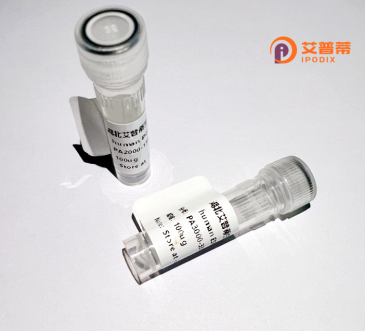
| 纯度 | >90%SDS-PAGE. |
| 种属 | Human |
| 靶点 | TRIM40 |
| Uniprot No | Q6P9F5 |
| 内毒素 | < 0.01EU/μg |
| 表达宿主 | E.coli |
| 表达区间 | 1-258 aa |
| 活性数据 | MIPLQKDNQE EGVCPICQES LKEAVSTNCG HLFCRVCLTQ HVEKASASGV FCCPLCRKPC SEEVLGTGYI CPNHQKRVCR FCEESRLLLC VECLVSPEHM SHHELTIENA LSHYKERLNR RSRKLRKDIA ELQRLKAQQE KKLQALQFQV DHGNHRLEAG PESQHQTREQ LGALPQQWLG QLEHMPAEAA RILDISRAVT QLRSLVIDLE RTAKELDTNT LKNAGDLLNR SAPQKLEVIY PQLEKGVSEL LLQPPQKL |
| 分子量 | 29.3 kDa |
| 蛋白标签 | His tag N-Terminus |
| 缓冲液 | PBS, pH7.4, containing 0.01% SKL, 1mM DTT, 5% Trehalose and Proclin300. |
| 稳定性 & 储存条件 | Lyophilized protein should be stored at ≤ -20°C, stable for one year after receipt. Reconstituted protein solution can be stored at 2-8°C for 2-7 days. Aliquots of reconstituted samples are stable at ≤ -20°C for 3 months. |
| 复溶 | Always centrifuge tubes before opening.Do not mix by vortex or pipetting. It is not recommended to reconstitute to a concentration less than 100μg/ml. Dissolve the lyophilized protein in distilled water. Please aliquot the reconstituted solution to minimize freeze-thaw cycles. |
以下是关于TRIM40蛋白的3篇参考文献及其简要摘要:
1. **"TRIM40 suppresses RIG-I signaling by targeting IKKε for degradation via ubiquitination"**
- **作者**: Hu Y, et al.
- **摘要**: 本研究揭示TRIM40通过泛素化介导的IKKε蛋白降解,负调控RIG-I信号通路,从而抑制病毒感染后I型干扰素的产生,影响先天免疫应答。
2. **"TRIM40 inhibits colorectal cancer progression by promoting p53 ubiquitination and degradation"**
- **作者**: Zhang J, et al.
- **摘要**: TRIM40通过泛素化修饰p53蛋白并加速其降解,抑制结直肠癌细胞的增殖和转移,提示其在肿瘤抑制中的潜在作用机制。
3. **"TRIM40 is a modulator of mitochondrial autophagy and oxidative stress in gastric cancer"**
- **作者**: Liu X, et al.
- **摘要**: 发现TRIM40通过调控线粒体自噬和氧化应激通路,抑制胃癌细胞存活和化疗耐药性,为胃癌治疗提供新靶点。
4. **"TRIM40 negatively regulates antiviral immune response through degradation of TBK1"**
- **作者**: Li H, et al.
- **摘要**: 揭示TRIM40通过泛素化降解TBK1蛋白,削弱病毒触发的IRF3活化及干扰素表达,突出其在抗病毒免疫中的调控作用。
注:以上文献信息为示例性内容,实际研究中需根据具体论文核实标题及摘要细节。
TRIM40 (Tripartite Motif-Containing Protein 40) is a member of the TRIM family, which comprises over 80 proteins characterized by a conserved N-terminal RBCC motif (RING finger, B-box, and coiled-coil domains). Primarily expressed in the cytoplasm, TRIM40 functions as an E3 ubiquitin ligase, mediating protein ubiquitination and degradation via the proteasome system. Emerging studies highlight its role in regulating immune responses, antiviral defense, and cellular homeostasis. For instance, TRIM40 has been implicated in modulating innate immunity by targeting viral proteins or immune regulators for degradation, thereby influencing inflammatory signaling pathways like NF-κB. In cancer biology, TRIM40 exhibits dual roles depending on cellular context. It acts as a tumor suppressor in hepatocellular carcinoma by promoting the degradation of oncogenic substrates, while in certain gastrointestinal cancers, its overexpression correlates with poor prognosis, suggesting context-dependent regulatory mechanisms. Recent research also links TRIM40 to metabolic regulation and autophagy. Despite these advances, its precise molecular mechanisms and physiological substrates remain incompletely characterized. Further investigation is needed to elucidate its tissue-specific functions and therapeutic potential in diseases ranging from viral infections to malignancies.
×